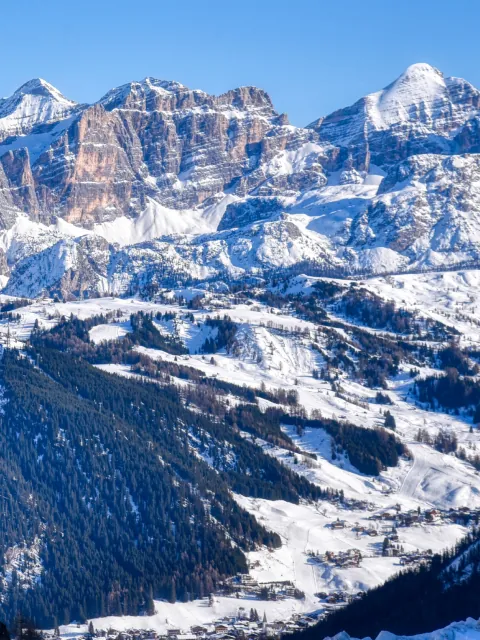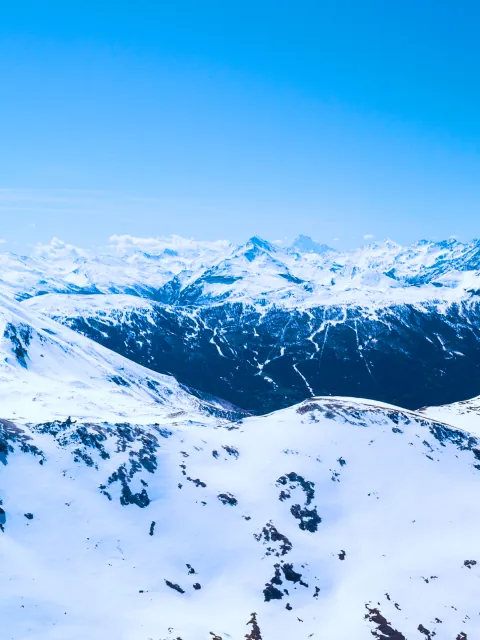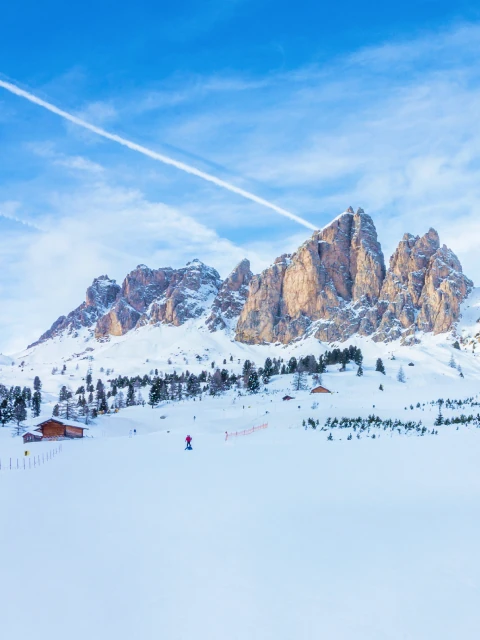

The Italian Dolomites are among the most striking and diverse ski destinations in Europe. Carved from ancient limestone and recognised as a UNESCO World Heritage Site, these mountains are home to jagged peaks, sprawling ski terrain, and charming alpine villages steeped in Italian, South Tyrolean, and Ladin traditions.
This guide covers everything you need to plan a ski trip in the Dolomites, whether it’s your first time or not. You’ll learn where the Dolomites are, how to get there, and what makes the region’s landscape and culture so unique. You’ll get a complete overview of the ski area, including its 12 iconic resorts, available lift pass options, the best months to ski, and how to get there.
The Dolomites are a stunning mountain range in northeastern Italy, stretching across the regions of South Tyrol (Alto Adige), Trentino, and Veneto. The region lies close to the Austrian border, with the nearest major cities being Bolzano, Trento, and Belluno. Popular valleys include Val Gardena, Val di Fassa, Alta Badia, and Ampezzo.
The Dolomites ski area is one of the largest and most scenic ski destinations in the world, covering 1,220 km (758 miles) of slopes across 12 unique ski areas that span 45 alpine villages and 12 valleys, all accessible with the Dolomiti Superski ski pass.
The terrain ranges in altitude from 1,500 to 3,200 metres (4,921 to 10,498 feet) and is supported by 450 modern lifts and extensive snowmaking, which covers over 1,100 km (683 miles) of slopes. The run breakdown includes 458 km (285 mi) of blue, 587 km (365 mi) of red, and 155 km (96 mi) of black pistes, making it an ideal playground for intermediate skiers, while also catering well to beginners, advanced skiers, cross-country enthusiasts, and freestylers. Additional features include 23 km (14 mi) of floodlit night skiing, well-equipped snow parks, and a wide network of cross-country trails.
At the heart of the region lies the legendary Sellaronda circuit, a 40 km (25 mi) ski tour that loops around the iconic Sella massif, linking four fully lift connected valleys: Val Gardena-Alpe di Siusi, Alta Badia, Val di Fassa/Carezza, and Arabba-Marmolada. While the loop is comfortably skiable in both directions in a single day, it's best to start early and allow time to soak it all in. The Sellaronda is more than a route, it’s a showcase of what makes skiing in the Dolomites so unique: beauty, variety, and adventure, all wrapped into one seamless journey.
Other renowned ski areas such as Cortina d’Ampezzo, Kronplatz (Plan de Corones), and 3 Zinnen (Tre Cime) are part of the Dolomiti Superski ski pass, though not physically interconnected. They can be easily reached by road.
Beyond the slopes, the Dolomites deliver a distinctive cultural blend of Italian, South Tyrolean, and Ladin traditions, set against cinematic UNESCO protected landscapes. With over 400 mountain huts serving local cuisine, the region combines world-class skiing with exceptional hospitality and alpine charm.
Skiing in the Dolomites is not just a holiday, it’s an experience defined by dramatic beauty, deep heritage, and a sense of place like nowhere else in the Alps. These mountains are unique. Carved from ancient marine limestone, the Dolomites rise in bold shapes (jagged spires, towering cliffs, and smooth plateaus), their pale rock glowing at sunrise and sunset in shades of rose and gold. Locals call this natural light show enrosadira, a Ladin word that perfectly captures the magic of these peaks. But the Dolomites offer far more than scenic views.
What makes them truly special is their diversity of landscapes, cultures, and skiing. One moment you’re gliding through a quiet forest in Alta Badia, the next you're crossing vast open bowls near Arabba or tracing a high ridge above 3 Zinnen. Each valley has its own flavour, not just in the food (which is exceptional) but in the architecture, language, and atmosphere. Italian, Austrian, and Ladin cultures all meet here, blending tradition with modern comfort.
The villages are charming and full of character. Many are family run, with cosy hotels, elegant chalets, and warm hospitality that keeps skiers returning year after year. The mountains themselves are welcoming too, ideal for beginners and intermediates, but with serious terrain for experts, including glacier skiing on Marmolada and legendary World Cup runs in Val Gardena and Alta Badia. And the infrastructure?
It’s among the best in the world. High-speed lifts, perfectly groomed pistes, and efficient connections make it easy to explore.

The largest area in Dolomiti Superski (~181 km/112 mi) brings together the three Val Gardena villages (Ortisei, Santa Cristina, Selva), with the broad, sun kissed meadows of Alpe di Siusi. Expect a huge spread of blue/red mileage (52-108 km/32-67 mi) with 21 km/13 mi of blacks, excellent hut culture, and quick access to the Sellaronda in both directions. Terrain spans quiet pastoral slopes (Seiser Alm) to dramatic faces under Sassolungo, Seceda/Col Raiser and Dantercëpies; it’s a dream base for intermediates who want variety day after day.

A groomer’s paradise with 130 km/80 mi of slopes and 53 lifts, Alta Badia excels at long, confidence building blues and flowing reds across the Pralongià high plateau above Corvara, Colfosco, La Villa, San Cassiano. It plugs seamlessly into the Sellaronda, yet keeps a relaxed feel, punctuated by excellent mountain huts. Advanced skiers will want to tick off the Gran Risa World Cup giant slalom run; everyone else can roam wide open scenic terrain with consistent snowmaking.

Centered on Canazei and Campitello, Val di Fassa fan‑outs to Sella passes and connects into the Sellaronda, while Carezza sits under the Rosengarten/Catinaccio with slopes reaching 2,638 m/8,654 ft. Expect classic Dolomite scenery with adjacency to Sassolungo, Sella, Pordoi and even Marmolada; off the alpine pistes, the area maintains ~105 km/65 mi of cross‑country trails, making it a strong all‑rounder for mixed groups.

Arabba is the steepest, most demanding corner of the Sellaronda north‑facing, fast, and ideal for strong skiers who love fall‑line carving. From town you can swiftly ride to Marmolada (3,342 m/10,964 ft) for towering glacier scenery and long, sustained descents. This is the place to chase vertical, rack up serious red/black laps, and enjoy some of the Dolomites’ most dramatic high‑mountain vistas.

The Dolomites’ “queen” spreads across Tofana, Faloria-Cristallo and 5 Torri-Lagazuoi, with skiing roughly 2,200 to 2,950 m (7,217-9,678 ft) and ~95% snowmaking coverage. The sectors are not as seamless as the Sella areas, but with an early start and a plan you’ll unlock big view classics all day; families can head to Col Gallina for especially child friendly terrain. Village side, this is the most glamorous address in the Dolomites.

A broad, dome shaped summit above Brunico/Bruneck with ~107 km/66 mi of pistes between ~1,000 to 2,275 m (3,280 to 7,463 ft). The flat summit plateau gives learners and early intermediates room to progress, while long valley runs add variety. It’s also one of the easiest areas to reach by public transit, with rail access in the Puster Valley.

A quieter, scenery‑first destination: ~115 km/71 mi of perfectly groomed pistes served by 31 lifts, across the Sexten/Sesto Dolomites and villages like San Candido, Sesto, Dobbiaco, Villabassa. Think uncrowded slopes, panoramic ridgelines and a slower rhythm yet still plenty of variety across linked mountains. Train access via the Puster Valley is a bonus.

Branded the “gateway to the Dolomites,” this multi‑sector domain (Obereggen/Latemar, Alpe Cermis) blends family‑friendly gliding slopes with adrenaline kicks on speed runs notably Pala di Santa, a test piece with a ~58% gradient. A strong choice for mixed parties who value variety and well‑organized infrastructure.

Inside the Paneveggio-Pale di San Martino Nature Park, ~60 km/37 mi of slopes unfurl between 1,404 and 2,357 m (4,606-7,732 ft), drenched in sun and surrounded by serrated limestone spires. The map skews to red runs, making it perfect for progressing intermediates who love scenery as much as skiing.

A family‑friendly enclave with ~100 km/62 mi and 25 lifts, set above the Eisack/Isarco and Puster valleys. Two gondola served massifs Gitschberg and Jochtal are linked, serving mellow, confidence building pistes and huge views (up to 500 peaks). Great for a relaxed pace and shorter stays.

A magnet for ambitious skiers and race training, this area is known for steep, technical slopes headliners include the black La Volta (~2.4 km/1.4 mi long with ~630 m/2,066 ft of vertical). When you want mileage plus a challenge, it delivers.

~80 km/49 mi of mostly easy to moderate pistes spread between Alleghe and Val di Zoldo, framed by towering rock walls. Beyond the daytime cruisers, Zoldo offers night‑skiing (Tue–Sat), and there’s a fun park for boarders/freestylers. A classic for value and scenery.
The Dolomiti Superski pass is a single ticket that unlocks the network’s 12 ski areas, from the interconnected Sellaronda quartet (Val Gardena-Alpe di Siusi, Alta Badia, Val di Fassa/Carezza, Arabba-Marmolada) to stand-alone valleys like Cortina, Kronplatz and 3 Zinnen, so you can roam between 1,200 km (745 mi) of slopes without changing products. You can buy day or multi-day durations, opt for family configurations, and decide between a local area pass (cheaper, valid only in that valley) and the Dolomiti Superski pass (network wide). As a rule of thumb, choose the DS pass if you’re planning headline circuits such as the Sellaronda or the First World War tour (Giro della Grande Guerra/Gebirgsjägerrunde), or if you’re based in one of the four interconnected Sella areas and don’t want to watch for boundary lines during the day; otherwise a local pass can be better value for resort centric itineraries.
note: resorts in the Brenta Dolomites (i.e Pinzolo, Madonna di Campiglio, Passo Tonale) sit outside the Dolomiti Superski network and use separate passes.
The Dolomites ski season typically runs from early December to early April, with some high-altitude areas like Arabba and Cortina d’Ampezzo, often staying open into mid to late April, depending on snow conditions and Easter holiday timing.
The season kicks off in early December, often aligning with the Feast of San Ambrogio (around the 7th), and by mid-month most lifts are open. The pre-Christmas weeks (especially around mid December) are considered a hidden gem: quieter slopes, festive atmosphere, and better accommodation availability.
This is the busiest and most expensive time of the season. While the scenery and atmosphere are magical, pistes and restaurants will be crowded, and prices peak across the board.
Often regarded as the best month to ski in the Dolomites, January combines excellent snow conditions, low crowds, and competitive accommodation prices. It's cold, ideal for snowmaking and slope maintenance, and perfect for racking up kilometres on quiet runs.
The first half of February maintains great snow but gets busier due to UK half-term holidays and the Italian Carnival period, which spans about two weeks and significantly raises demand, especially in family friendly resorts.
As spring sets in, the weather softens, days get longer, and the Dolomites shine in the sun. Snow conditions in lower areas can become slushy by afternoon, but high-altitude sectors (like Marmolada) hold their snow well. This is a great time for relaxed skiing, sun terraces, and scenic lunches, just ski early in the day to enjoy the best snow.
While most valleys close by early April, a few areas such as Arabba and Cortina often remain open longer, offering spring skiing for those willing to chase the last snow. Conditions are variable but can still be sublime with early starts and well-planned days.
Getting to the Dolomites is relatively easy thanks to multiple international airports and well connected road and rail infrastructure. Here are some ideal airports depending on your resort of choice: